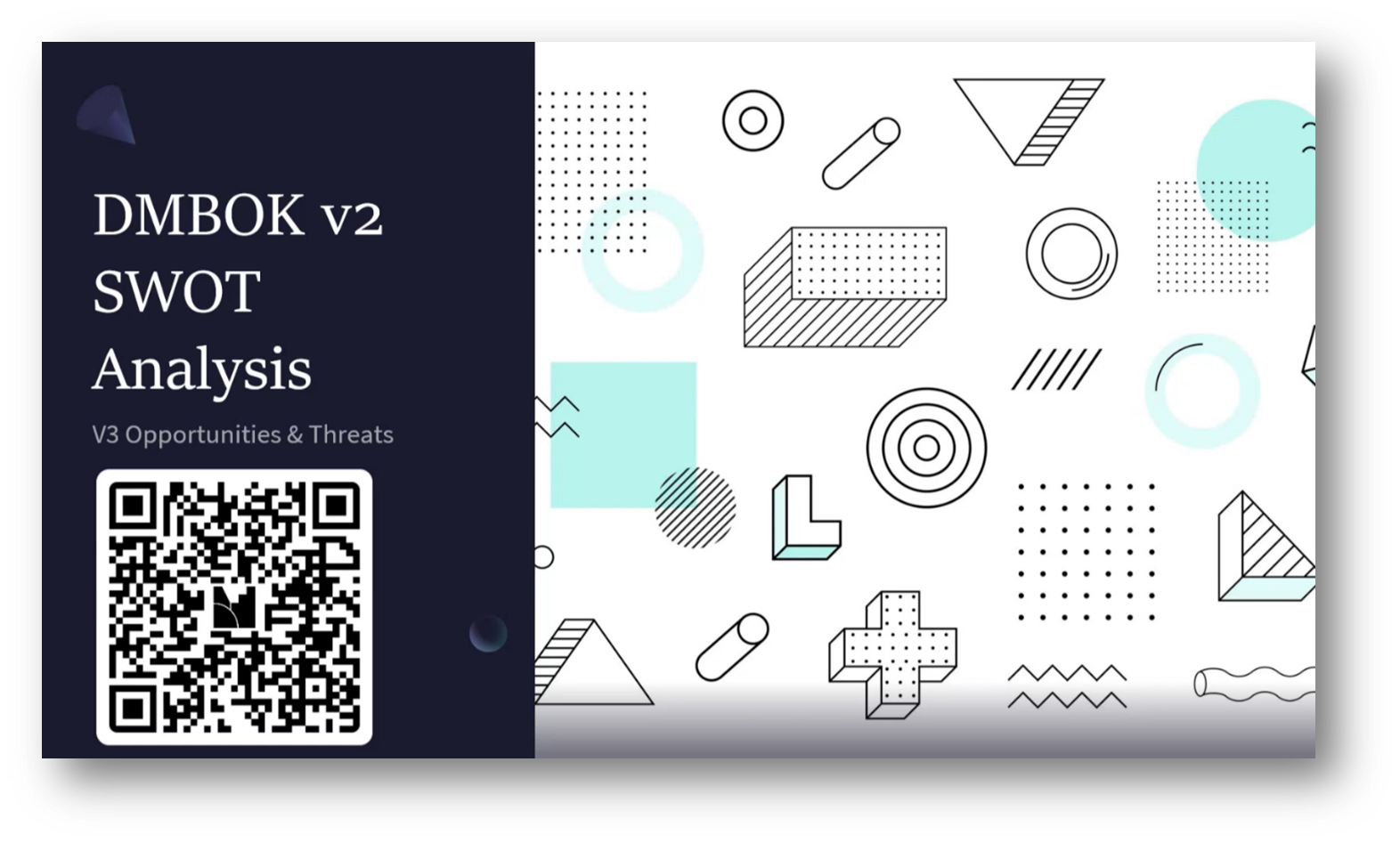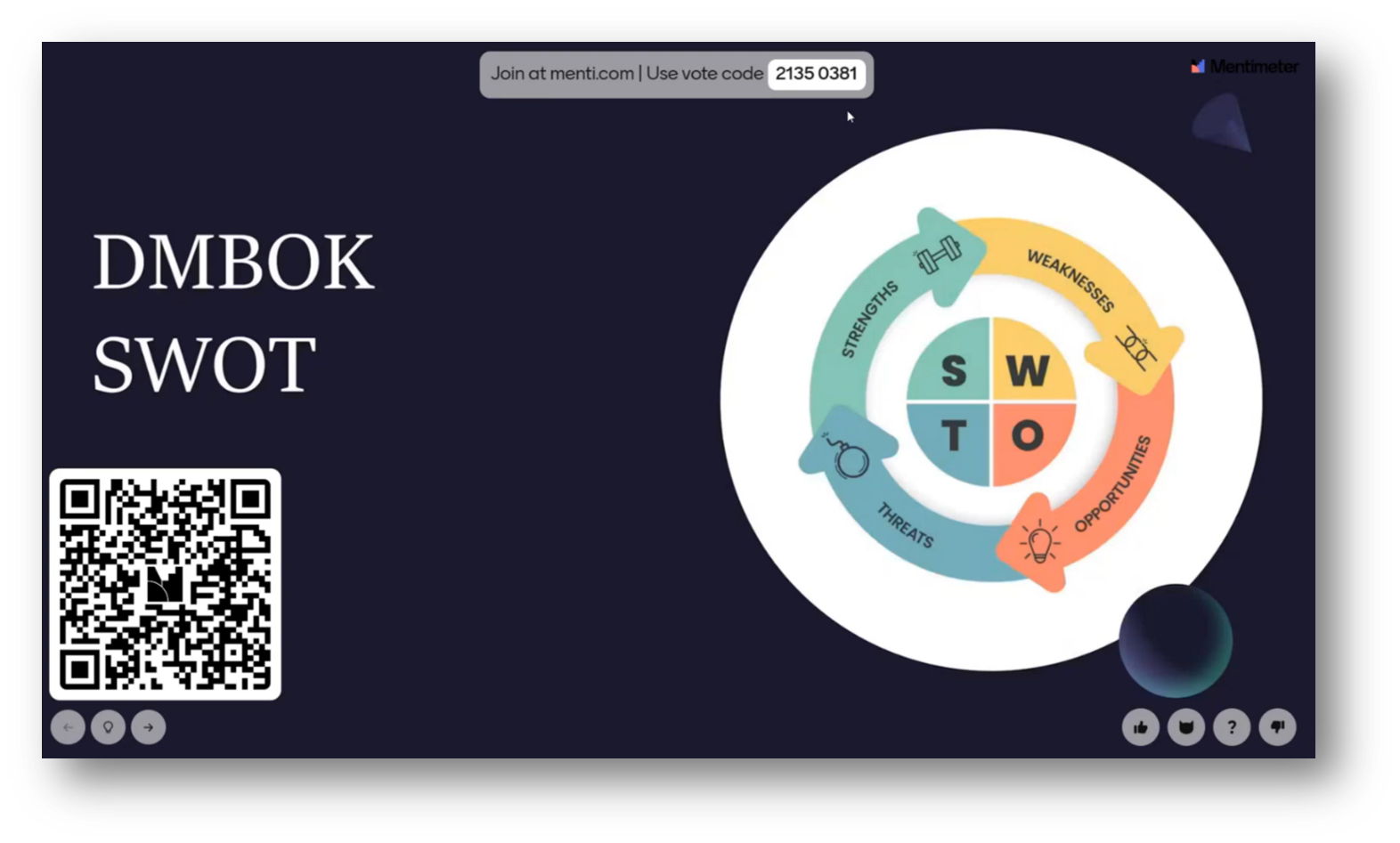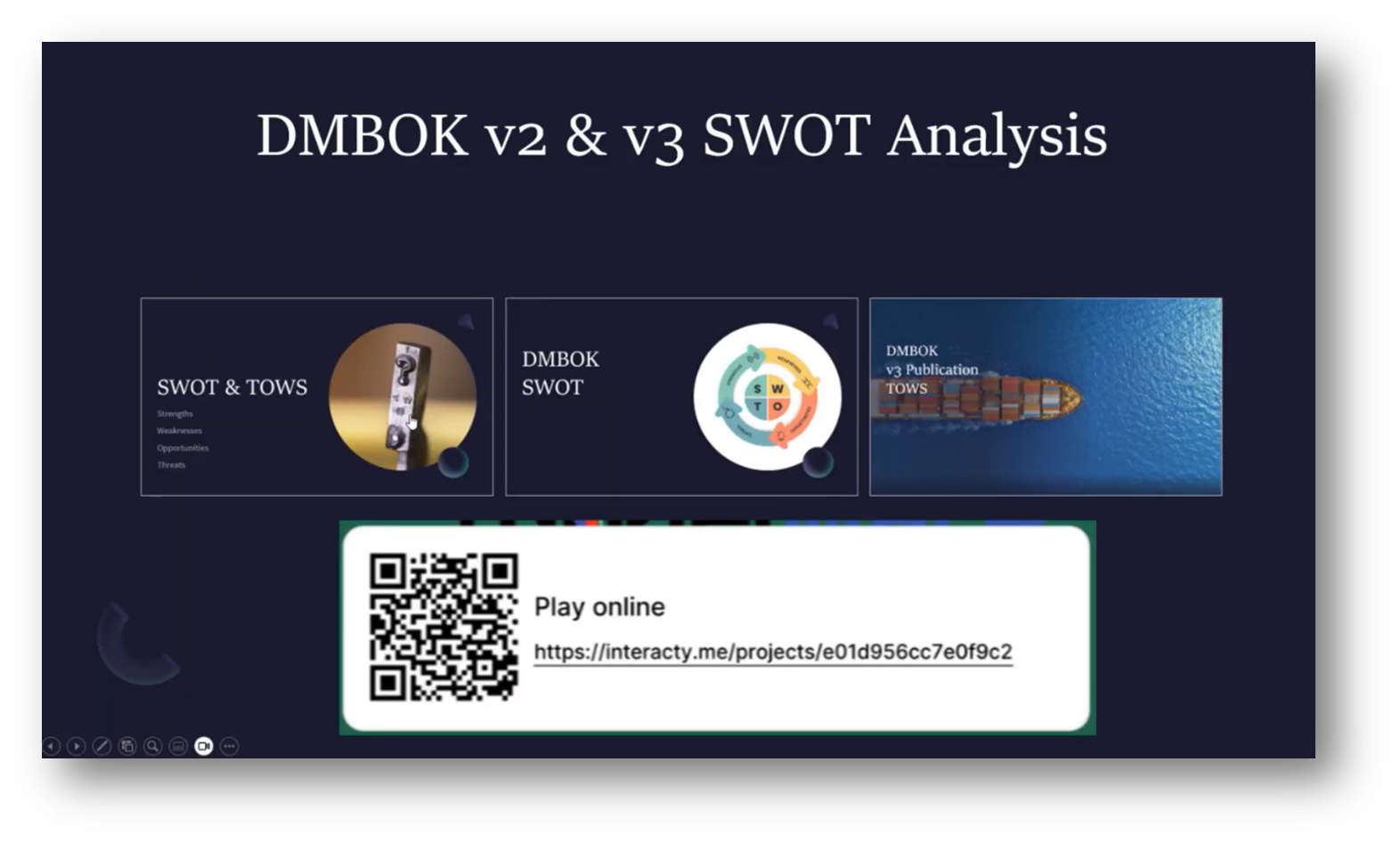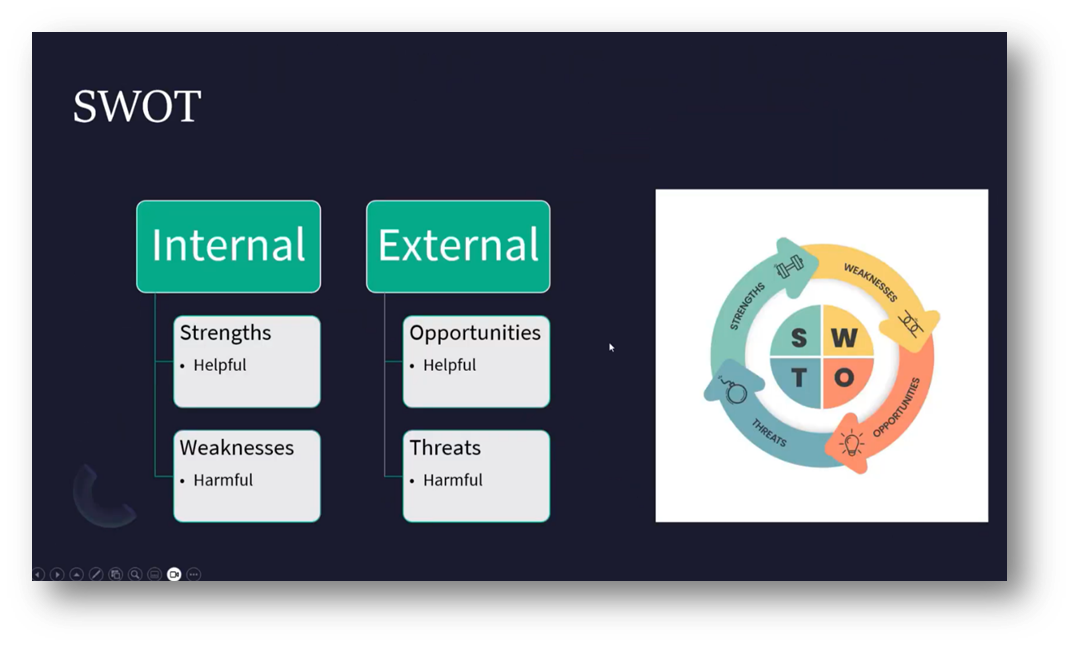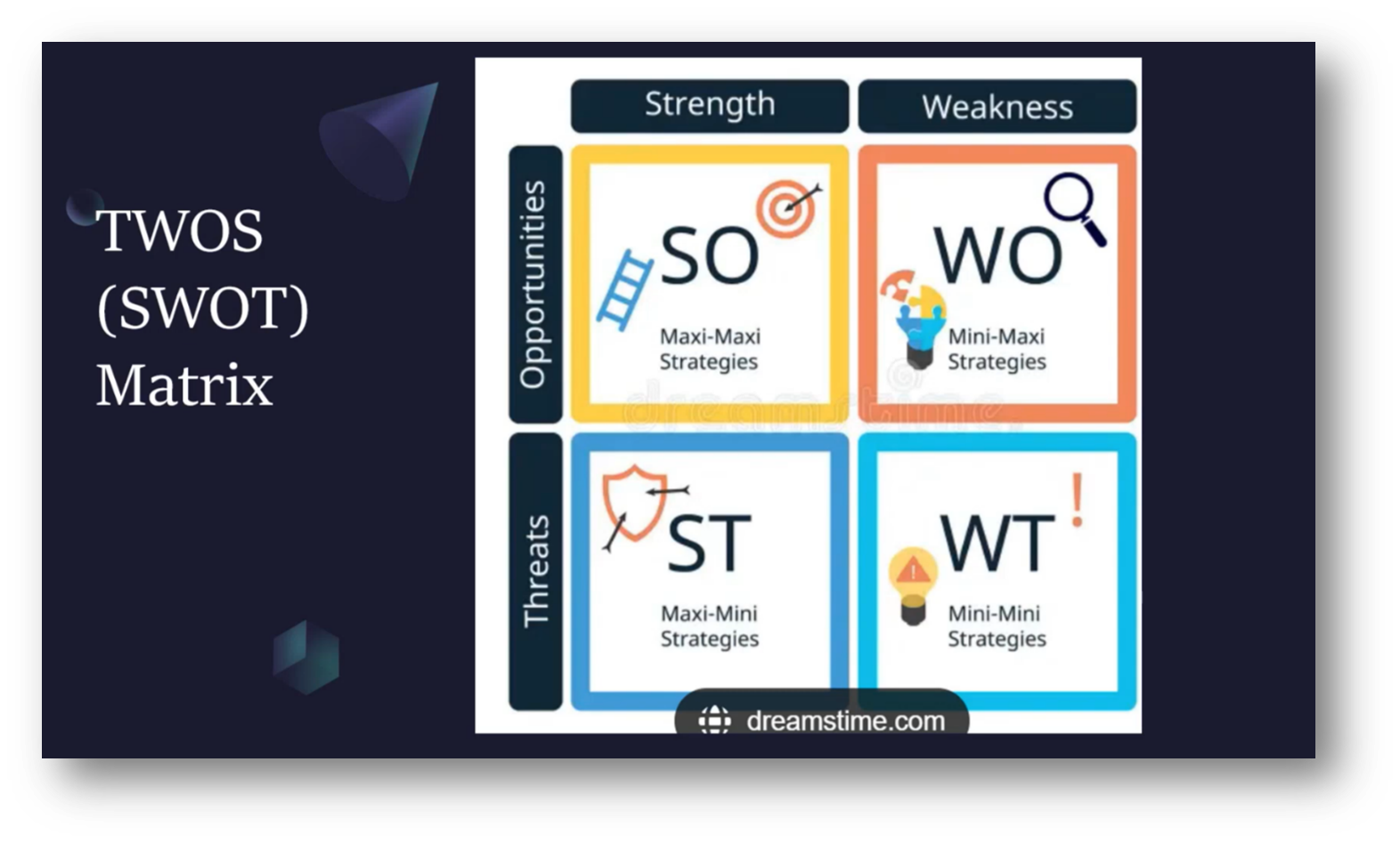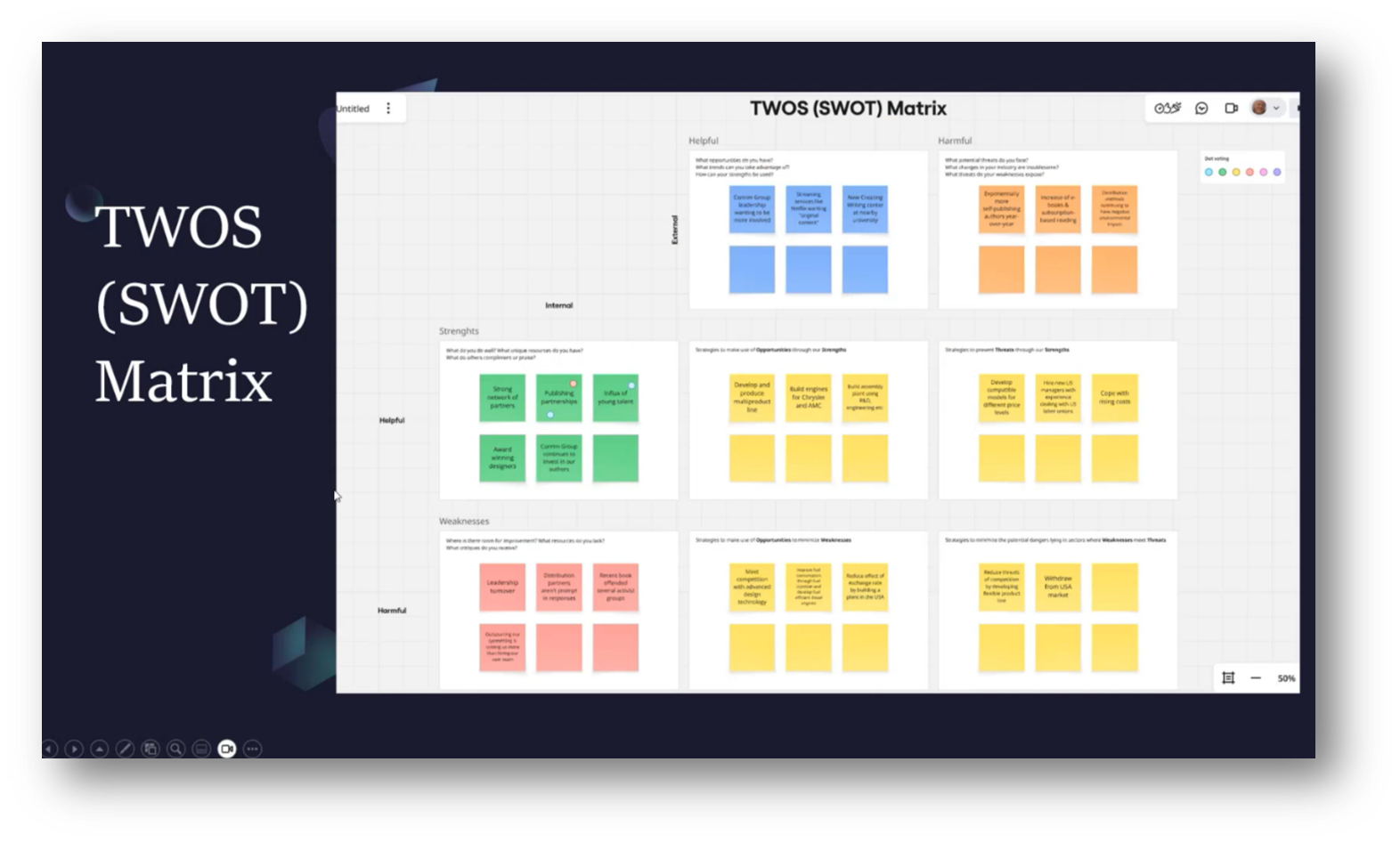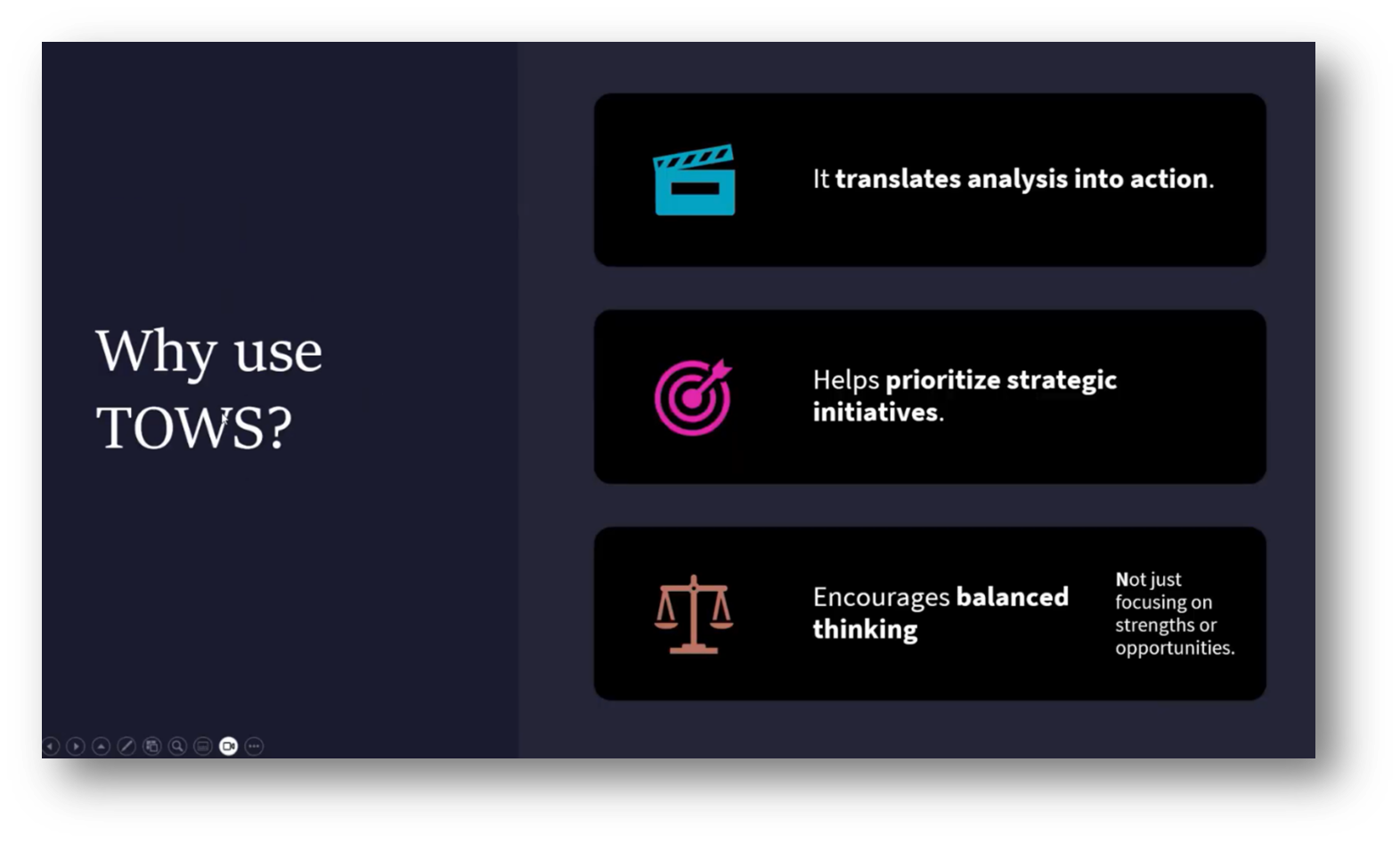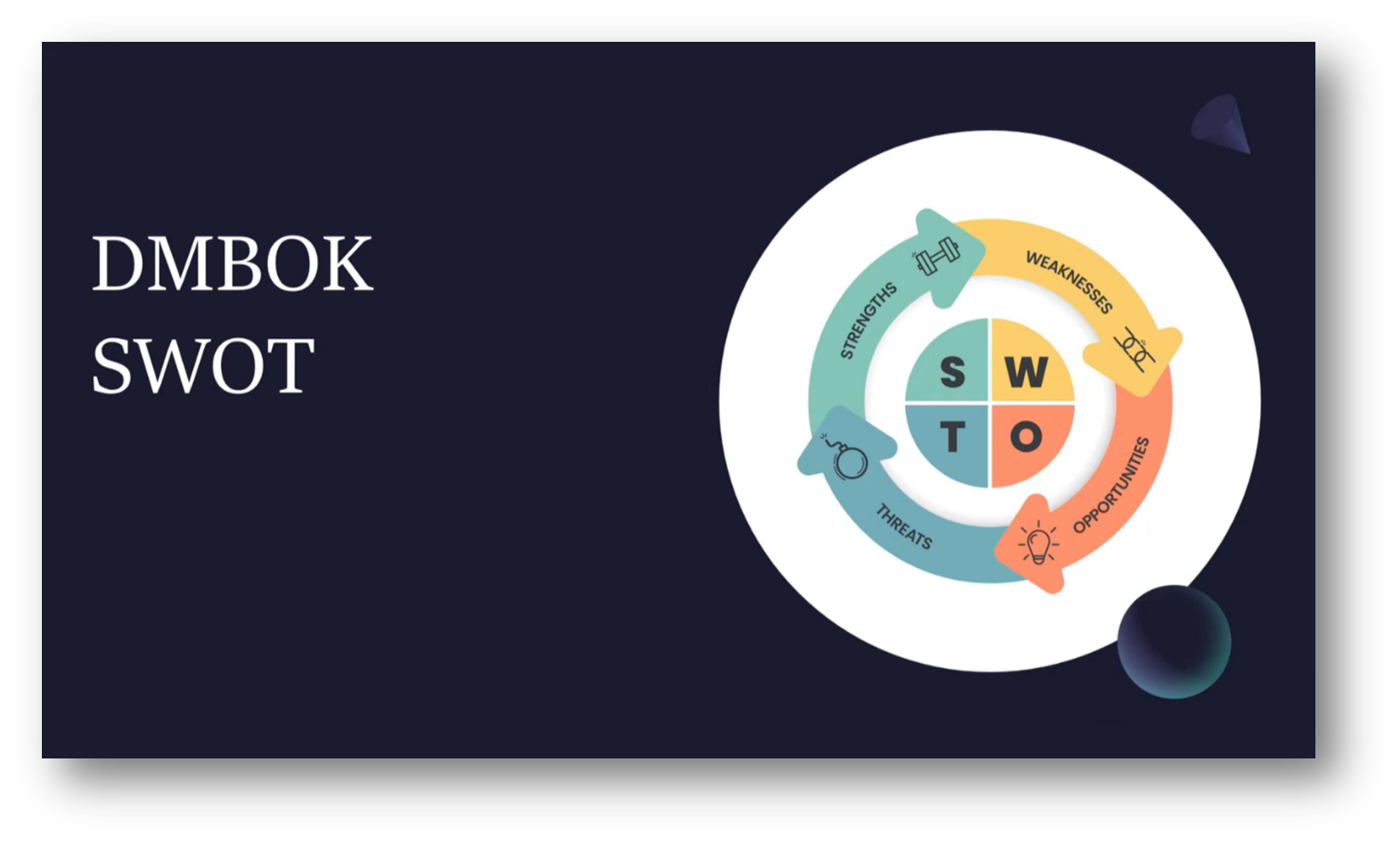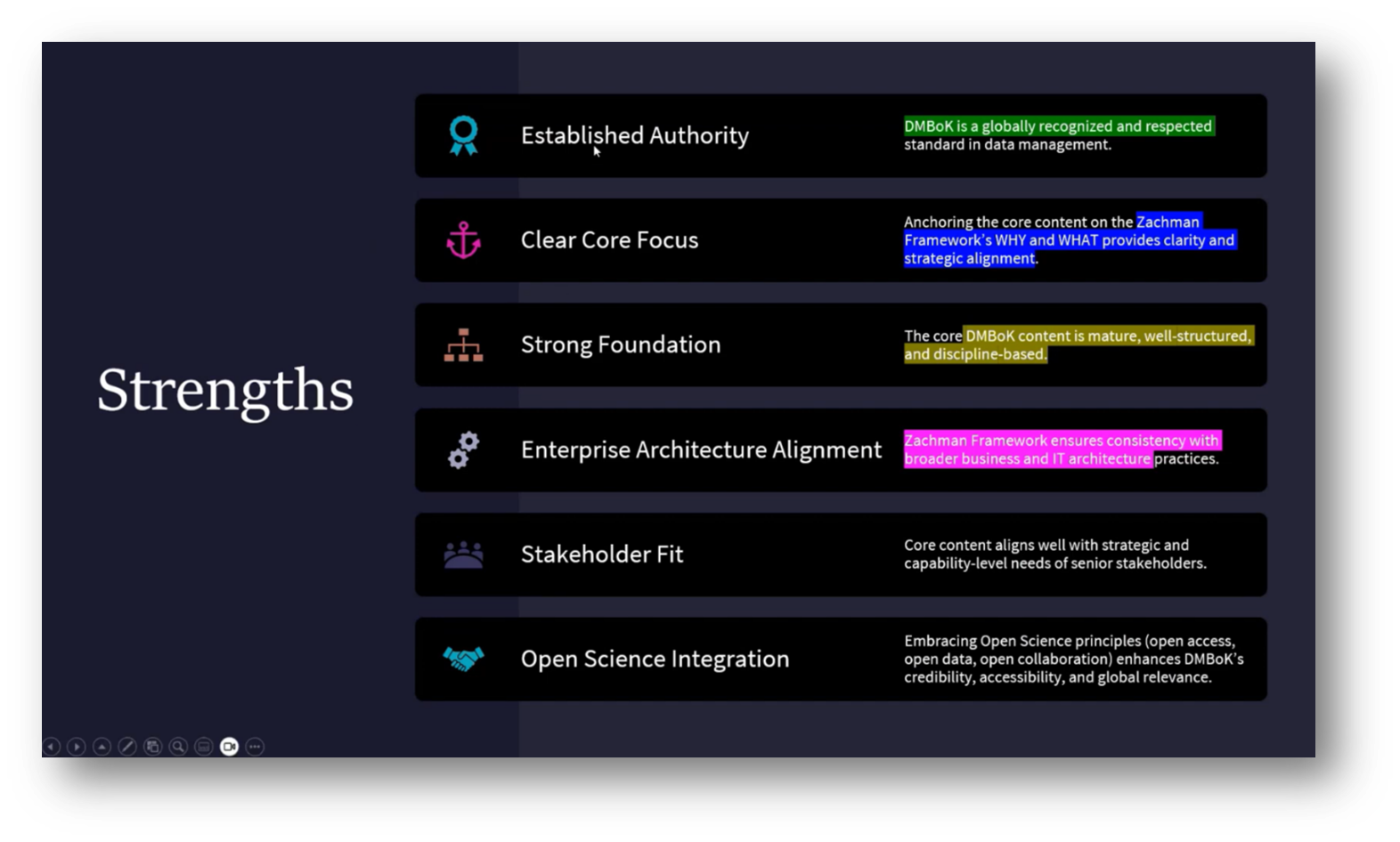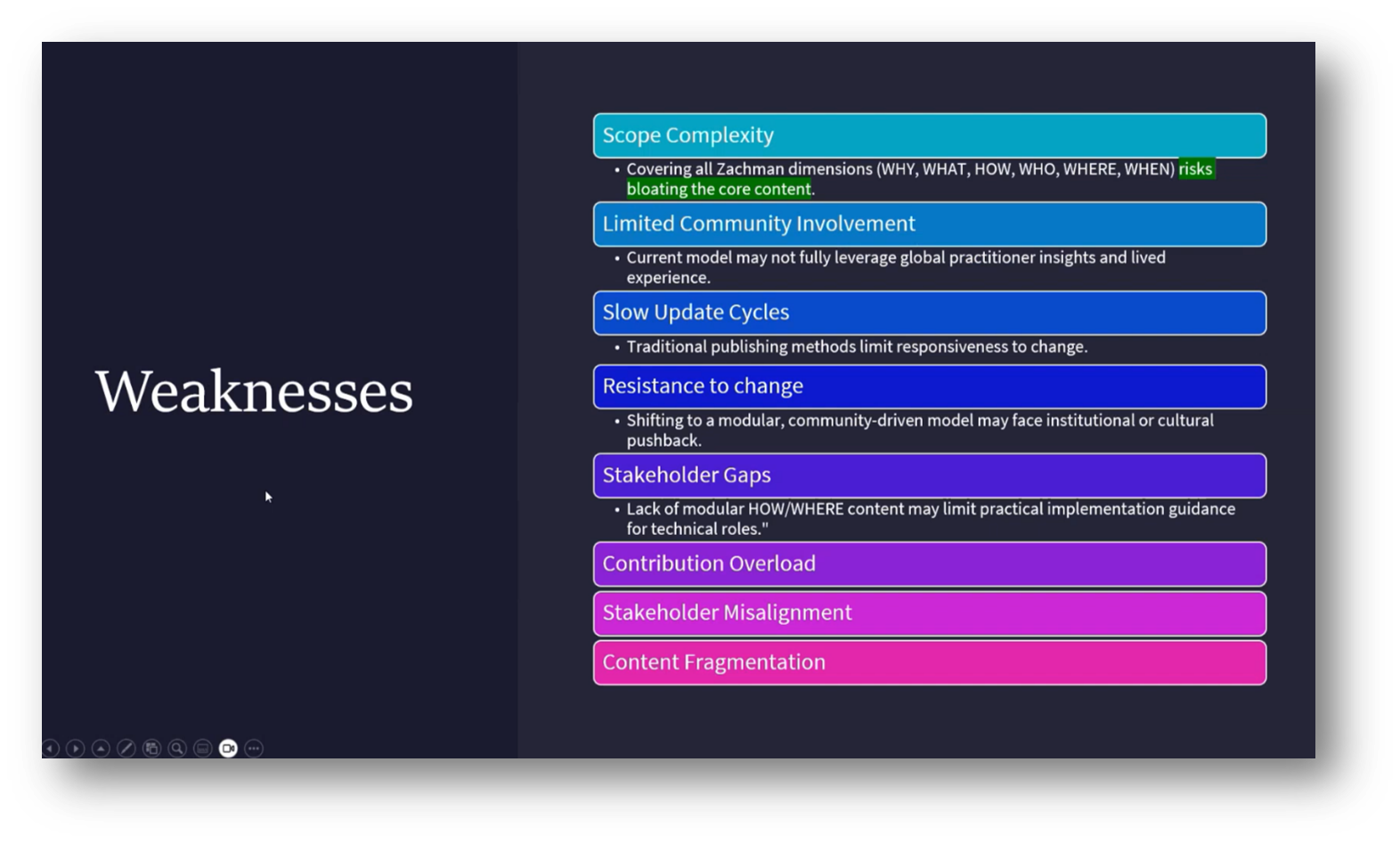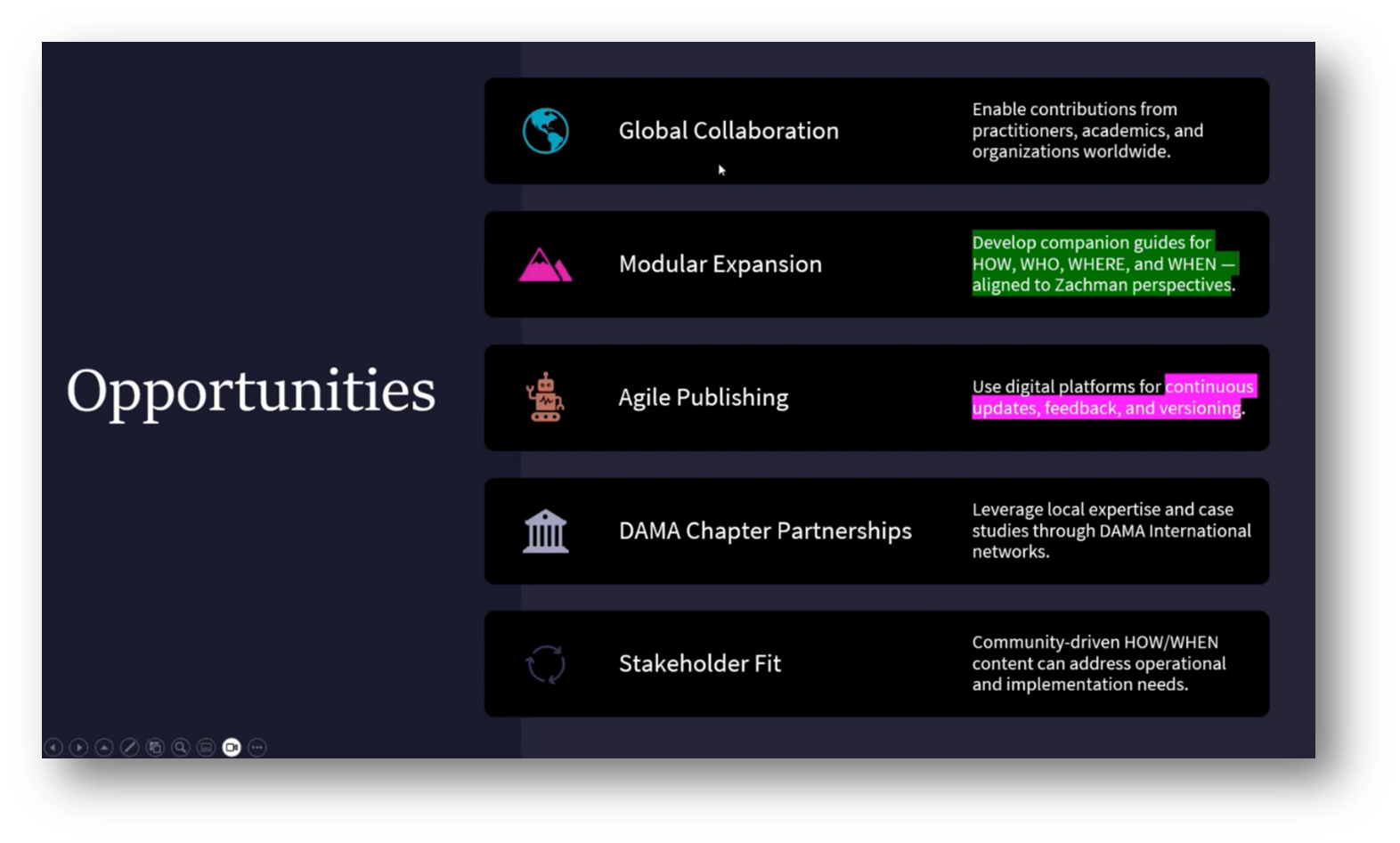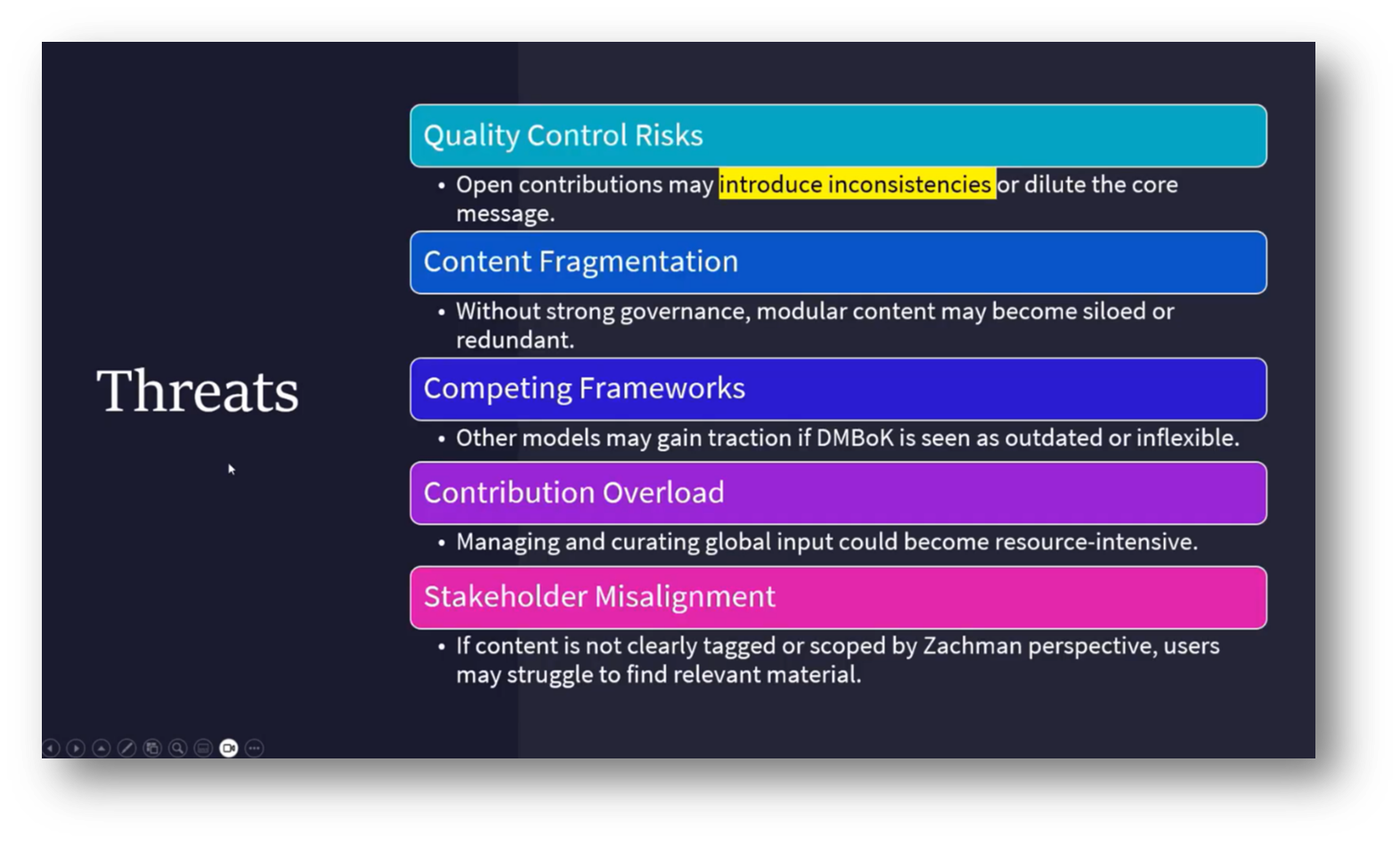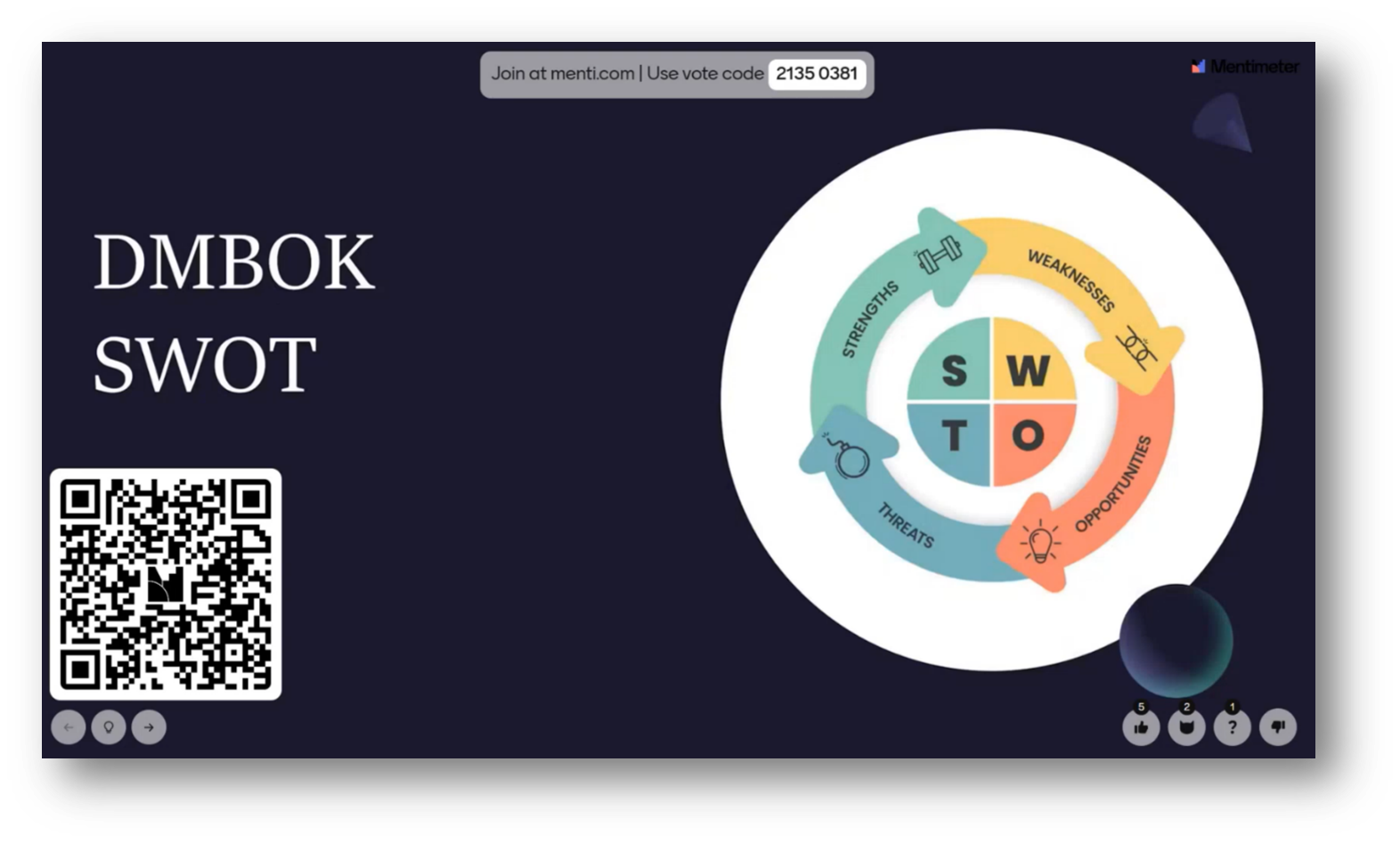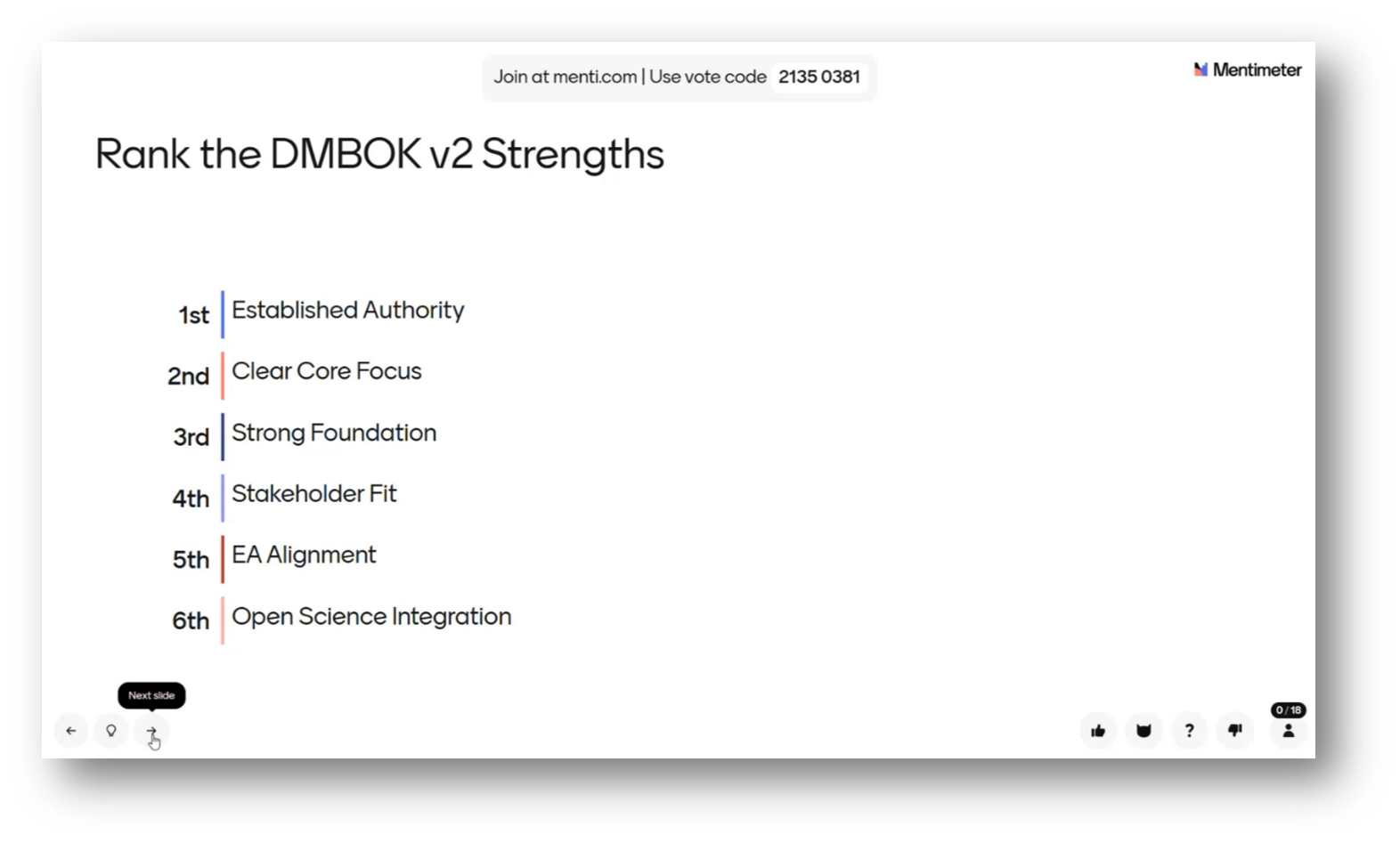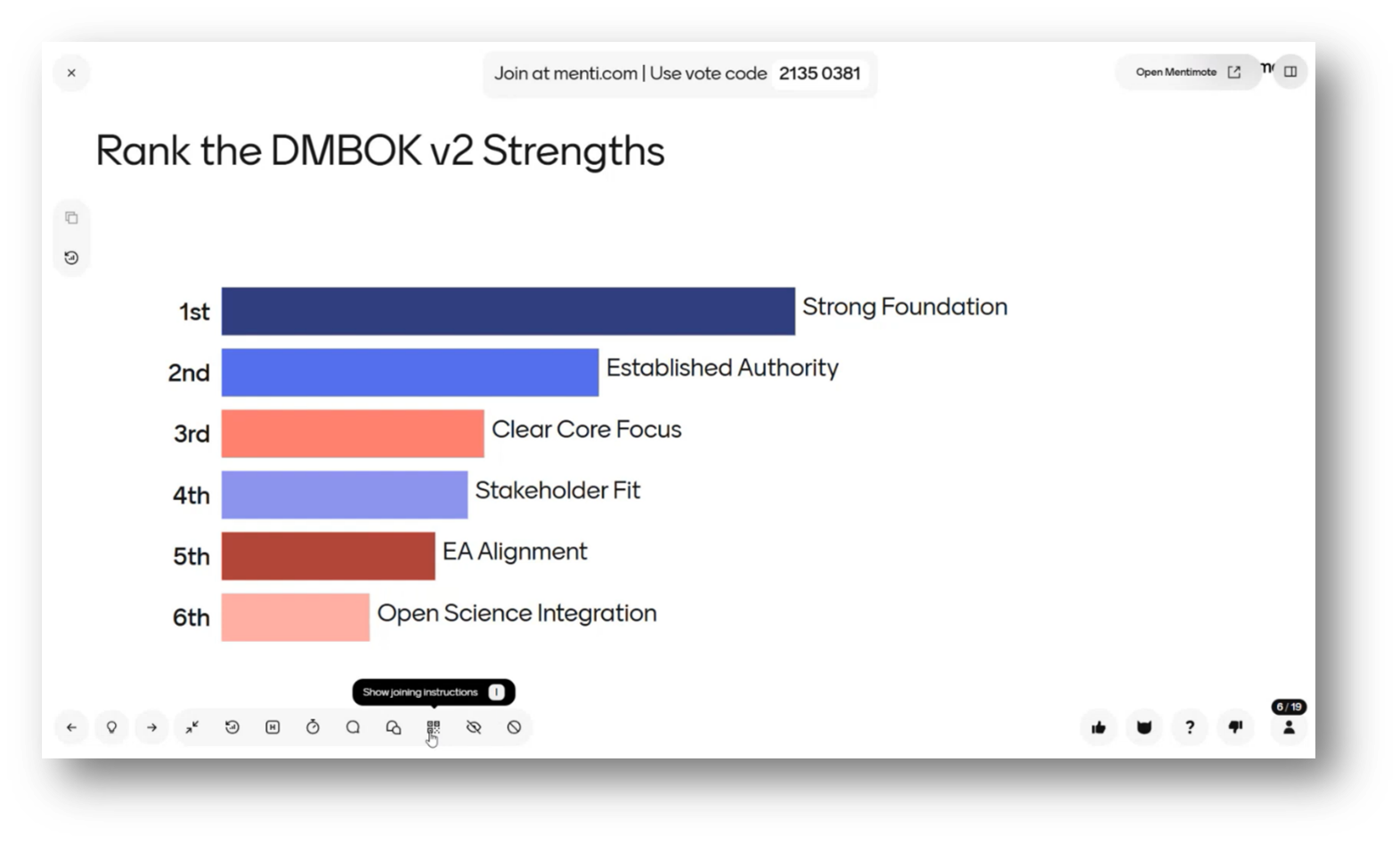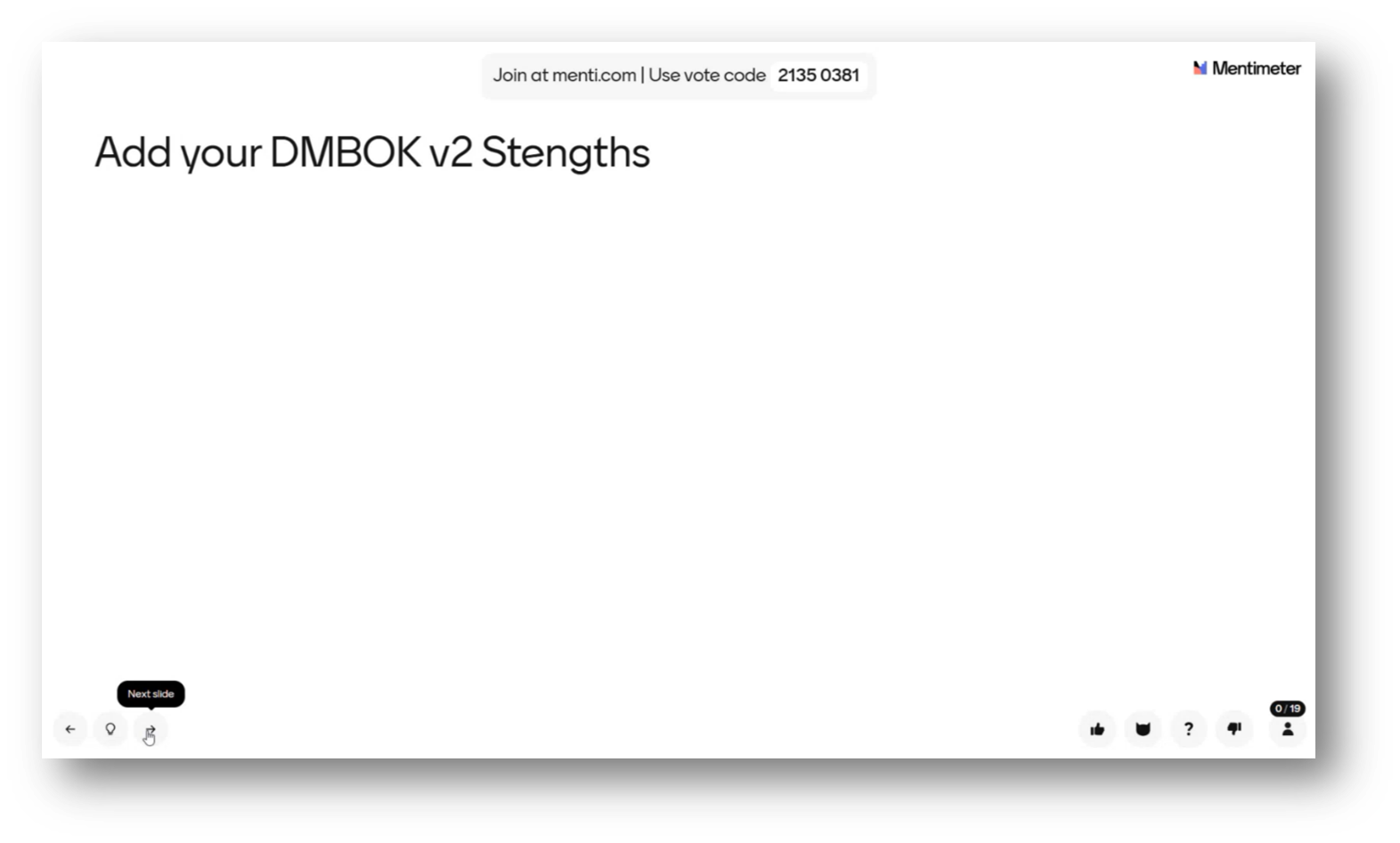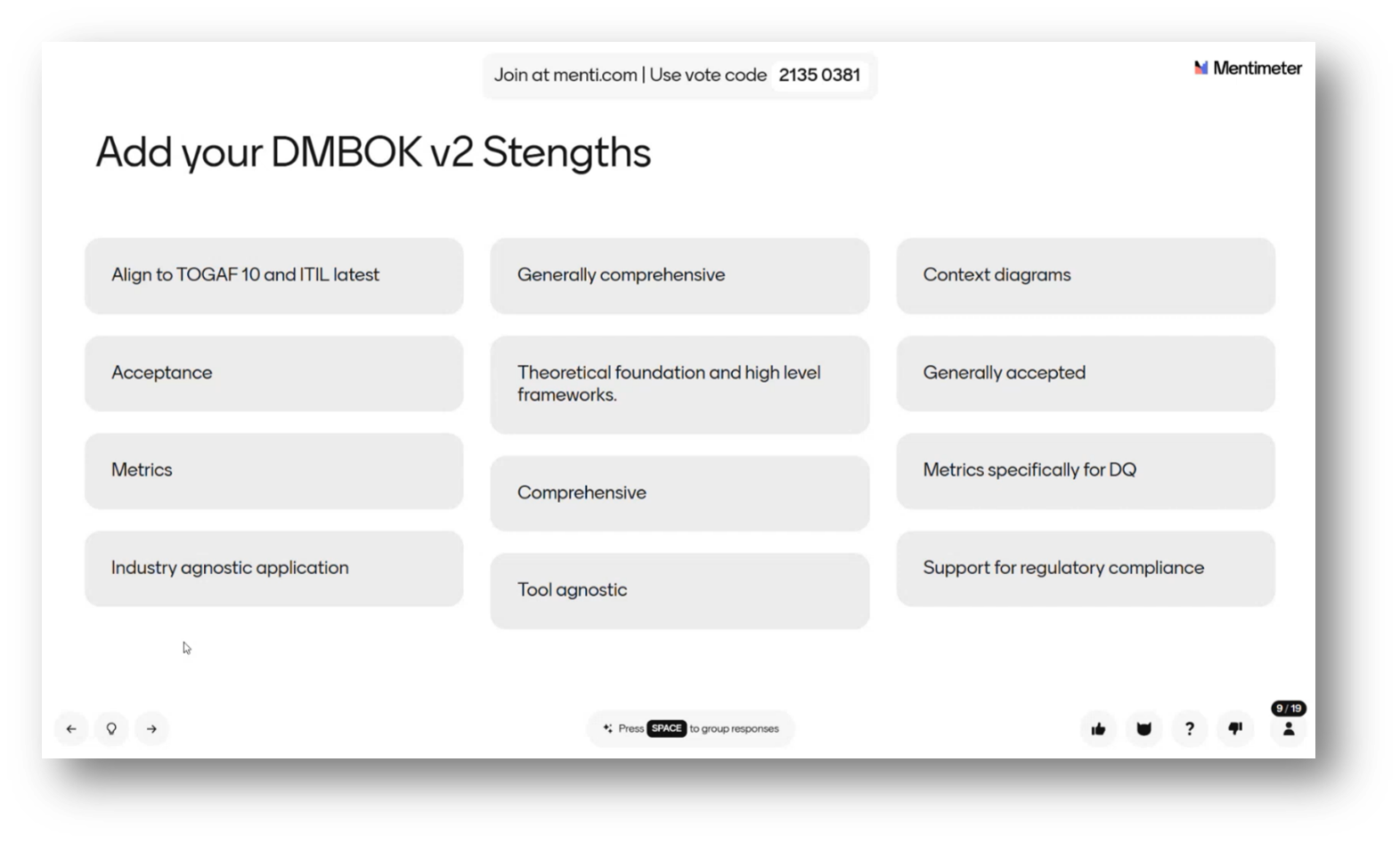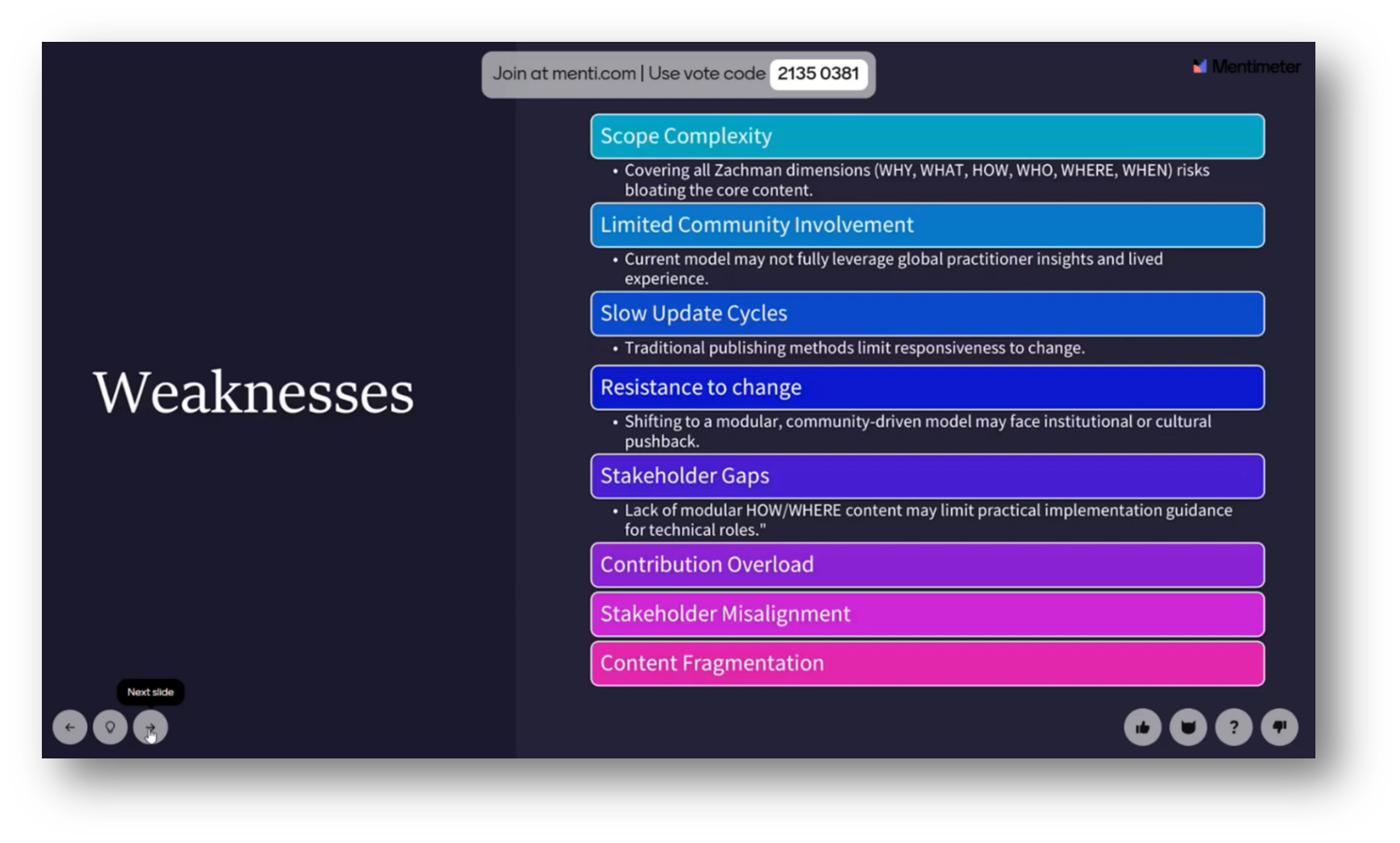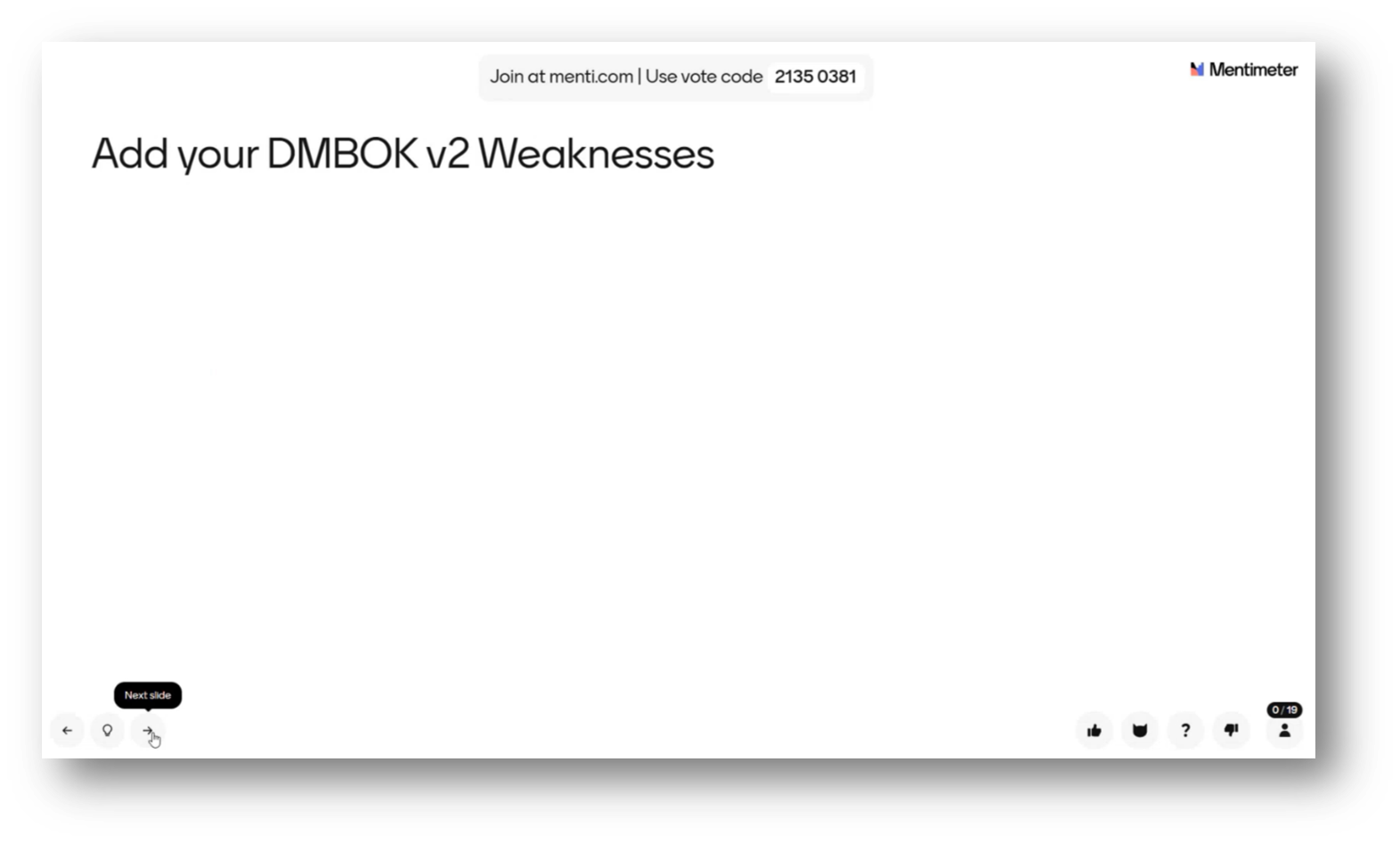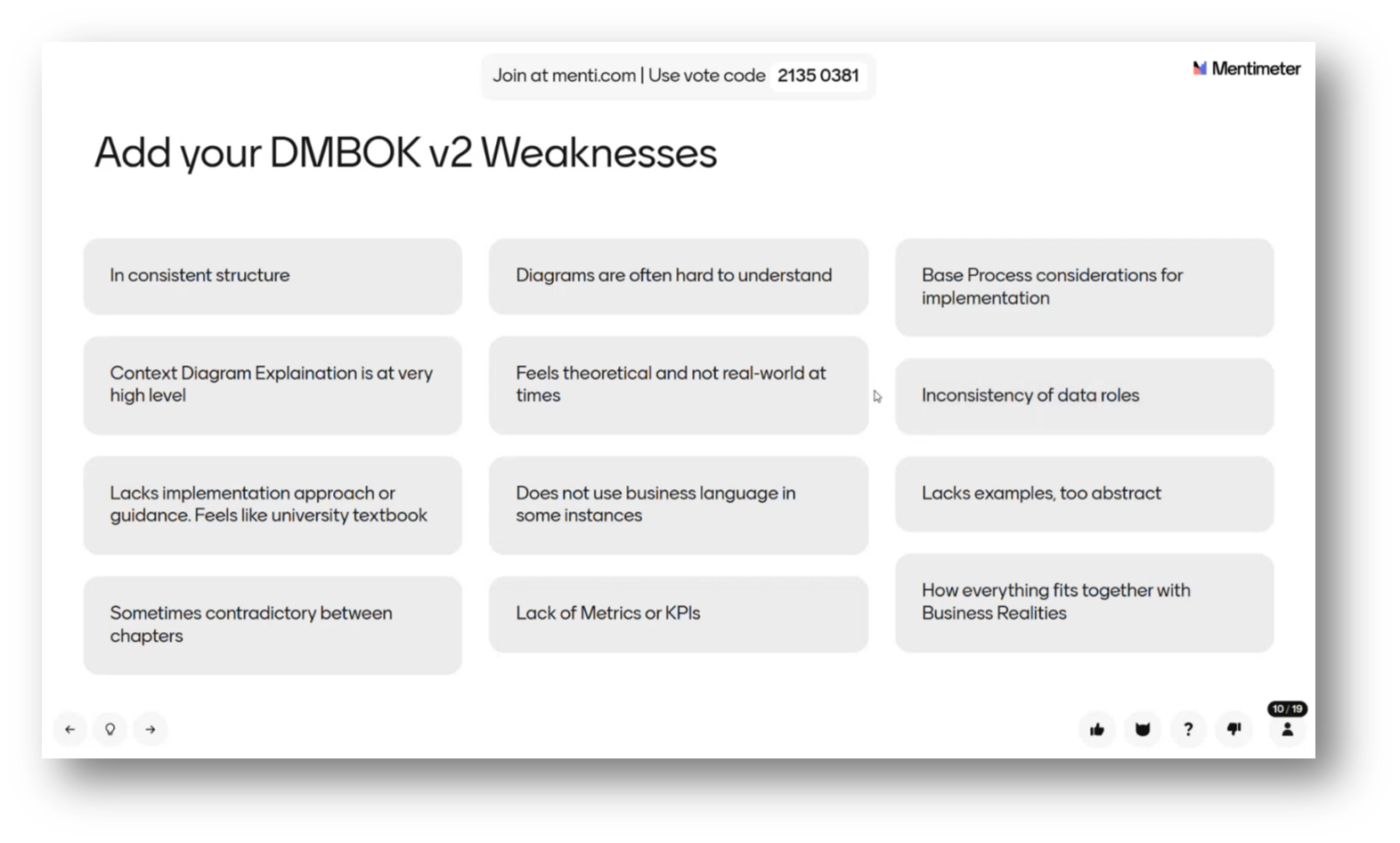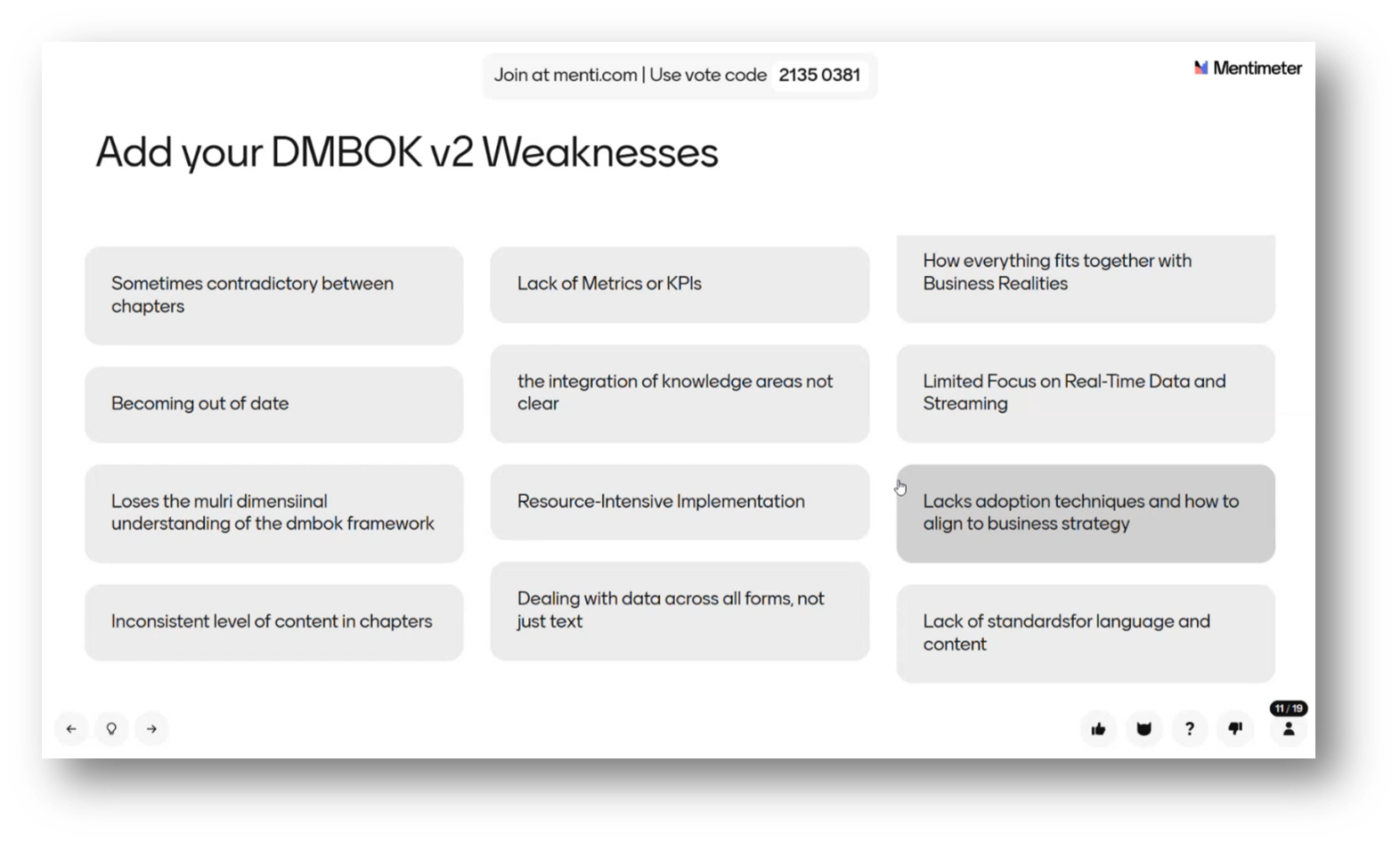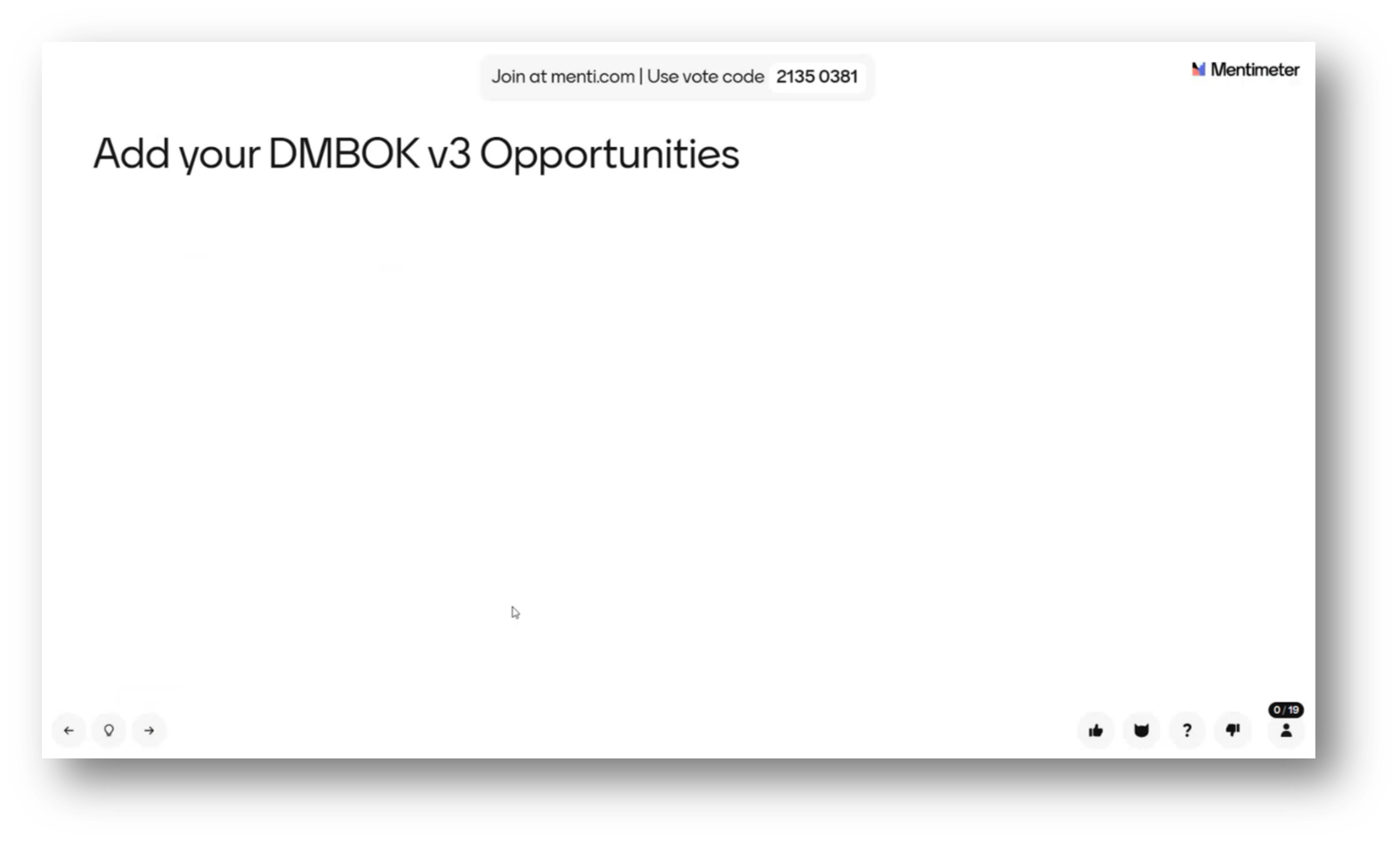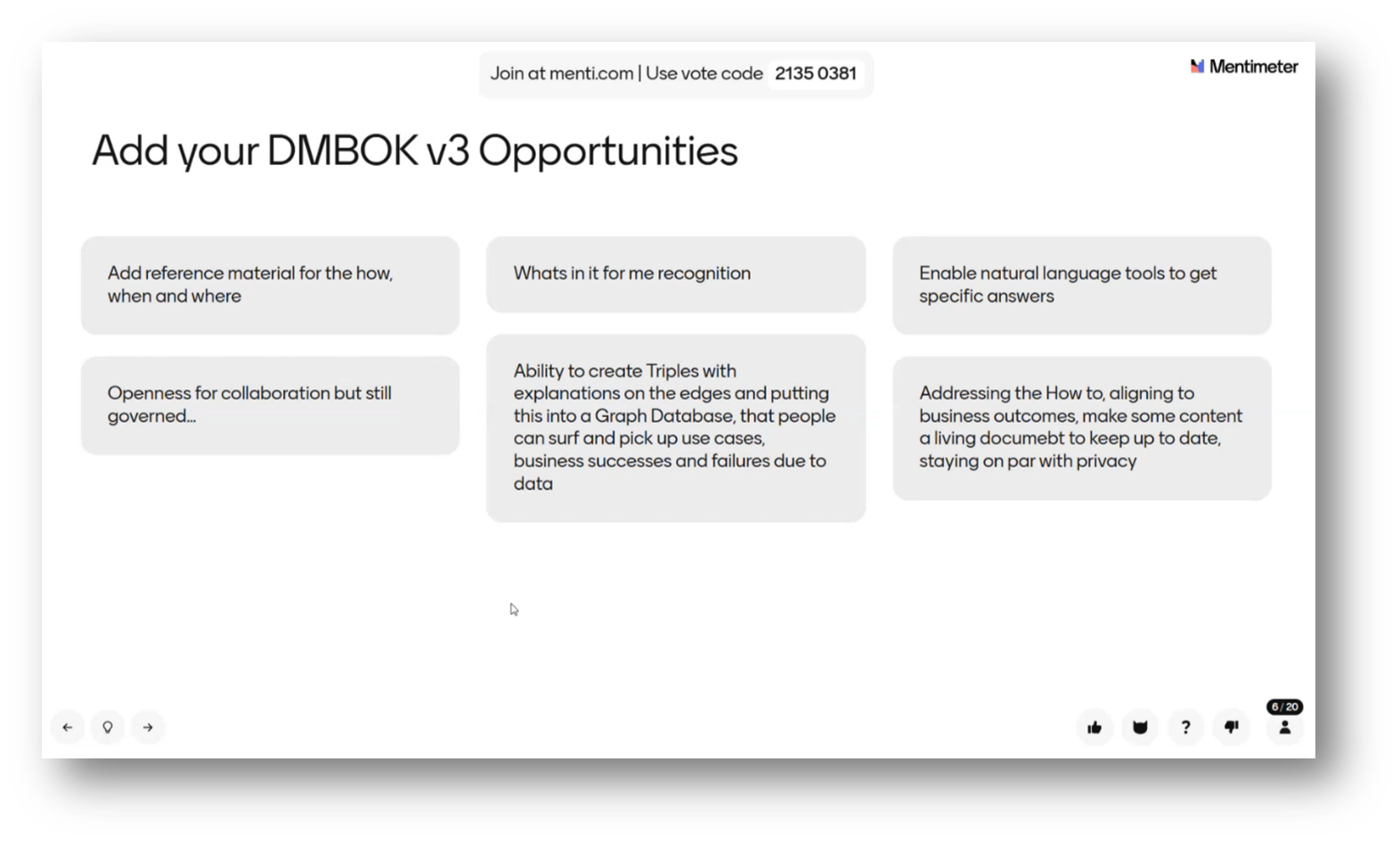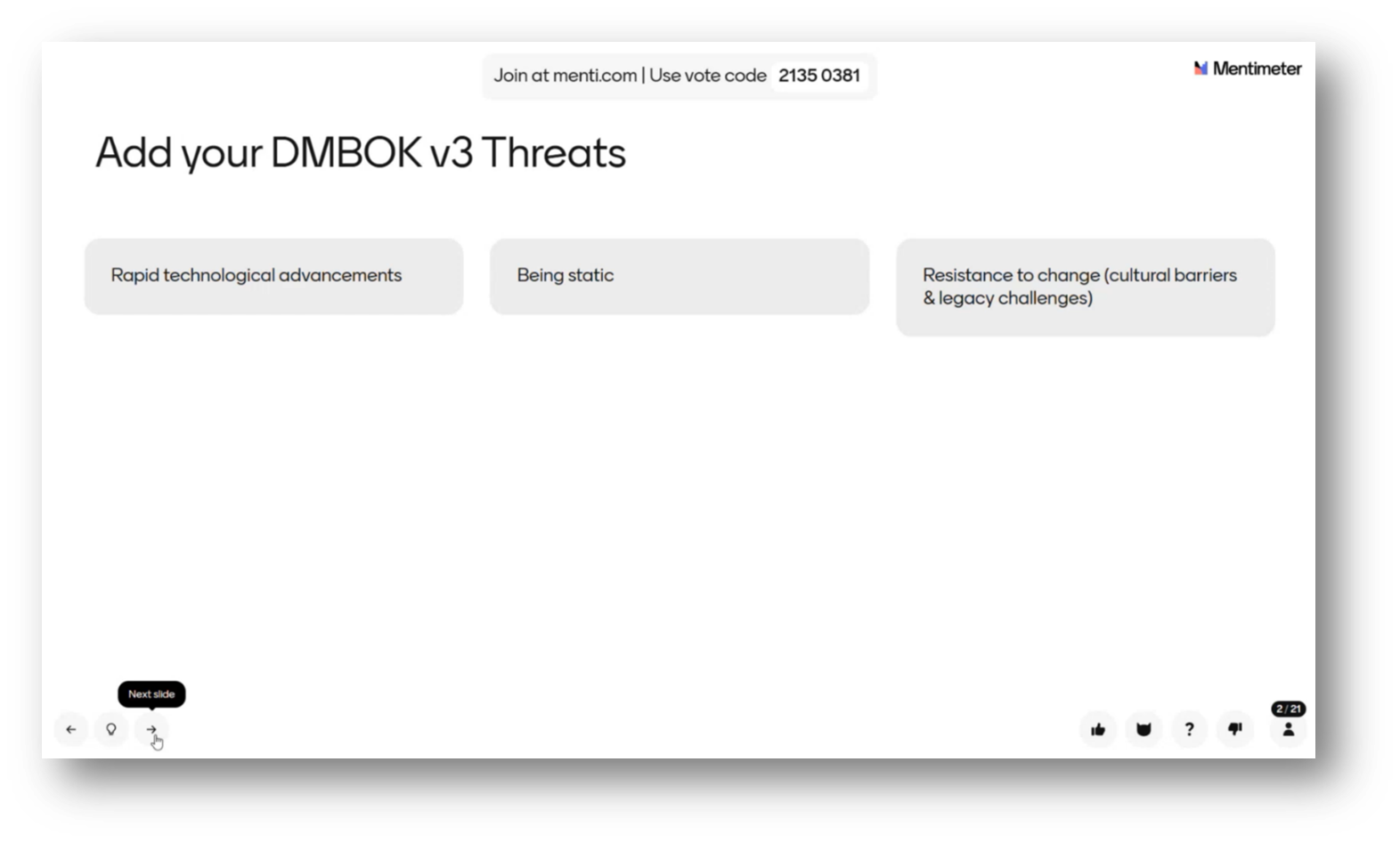Exploring the Data Management Body of Knowledge (DMBoK) for Data Managers
Executive Summary
This webinar highlights critical areas of focus for enhancing Data Management and content collaboration across various domains. Howard Diesel examines the strengths and weaknesses of the Data Management Body of Knowledge (DMBoK), proposing opportunities for improvement in both Version 2 and Version 3. The analysis emphasizes the need for effective data strategies, trend analysis, and the development of robust content publishing systems to combat challenges such as content fragmentation and knowledge silos.
The webinar addresses the importance of global collaboration and open science integration in academia and industry, while advocating for innovative strategies to overcome obstacles in content implementation. Lastly, Howard underscores the significance of recognising intellectual property in content creation on social media platforms to foster a more collaborative and effective content management environment.
Webinar Details
Title: Exploring the Data Management Body of Knowledge (DMBoK) for Data Managers
Date: 03/07/2025
Presenter: Howard Diesel
Meetup Group: African Data Management Community
Write-up Author: Howard Diesel
Contents
Strategy, Survey and Content Collaboration
Crossword Puzzles, Data Strategy and Trend Analysis
Strengths and Weaknesses of the DMBoK: The Potential for Improvement
Opportunities, Threats, and Market Dynamics
Development of the Content Publishing System
Challenges in Content Implementation and Content Structure
Content Fragmentation and Knowledge Silos in Data Management
Global Collaboration, Challenges in Academic Integration and Publishing Strategies
Team Collaboration and Feedback Session
Open Science Integration and Data Management
Weaknesses and Challenges in the DMBoK Version 3 and Version 2
Promoting Global Collaboration and Content Management in Open Platforms
Content Creation, Recognition, and Intellectual Property on Social Media Platforms
Data Management and Open Science in Academia and Industry
Strategy, Survey and Content Collaboration
Howard Diesel opens the webinar and introduces the initial phase of the editorial project for the Data Management Body of Knowledge (DMBoK) Version 3. Howard shares his wish to conduct a survey focused primarily on gathering feedback about Version 2, while also setting the stage for insights on Version 3. Additionally, crafting effective survey questions is crucial, as they must yield meaningful quantitative data to inform our understanding of the topic.
A Strengths, Weaknesses, Opportunities, and Threats (SWOT) analysis will be conducted to evaluate the strengths and weaknesses of Version 2, as well as the opportunities and threats posed by Version 3. The aim is to establish a publication and content portal that allows contributions from various individuals, ensuring that new content aligns with the defined core Knowledge Areas and is appropriately tagged within the Data Management Framework.
Figure 1 DMBOK V2 SWOT Analysis
Figure 2 DMBoK SWOT
Crossword Puzzles, Data Strategy and Trend Analysis
In a recent presentation, an online crossword puzzle was introduced, which sparked discussions among participants. Attendees were encouraged to learn and engage with the material, as clues to solve the crossword puzzle were present throughout the presentation.
Howard then emphasised the importance of integrating a SWOT analysis into data strategy, noting that while many utilise the basic framework, few apply it to specific scenarios, particularly the "towers" aspect, which was highlighted as crucial. Additionally, the SWOT framework categorises strengths and weaknesses as internal factors and opportunities and threats as external ones.
Figure 3 DMBoK Version 2 and Version 3 SWOT Analysis
Strengths and Weaknesses of the DMBoK: The Potential for Improvement
The strengths of the DMBoK include its established authority and recognition in the field. However, a notable weakness is that it has become outdated, requiring updates to maintain its relevance. An opportunity for improvement would be to create a platform that encourages global collaboration, allowing continuous contributions and corrections to the content. Additionally, addressing inconsistencies and errors, such as the confusion surrounding names in the text. Past editions, particularly Version 2, were produced by only a few contributors, highlighting the need for broader participation to enhance the accuracy and completeness of the material.
Figure 4 SWOT and TOWS
Figure 5 Strengths, Weaknesses, Opportunities and Threats
Opportunities, Threats, and Market Dynamics
In developing a data strategy, it's crucial to analyse not only strengths and weaknesses but also opportunities and threats to avoid skewed perceptions that lean overly positive or negative. A common issue arises when stakeholders provide numerous weaknesses and minimal opportunities; thus, initiating discussions with use case ideation can help identify potential opportunities.
It’s essential to explore how strengths can be leveraged to capitalise on these opportunities while acknowledging that weaknesses may enable new competitors to enter the market as threats. For instance, competing frameworks can pose significant challenges, particularly as industries evolve with advancements in cloud and AI, necessitating a proactive approach to maintain leadership in the field.
Figure 6 "TWOS (SWOT) Matrix"
Development of the Content Publishing System
The EDM Council is recognised as a capability assessment model rather than a maturity assessment model, which distinguishes it within the industry. Traditionally, the EDM Council has not positioned itself as a framework for capability assessment.
Terms such as "maxi-maxi" for helpful strengths and opportunities were introduced by Howard, alongside "mini-mini," which highlights threats stemming from weaknesses. This emphasises the need to leverage opportunities to improve weaknesses, illustrating the complexities of strategic planning.
Howard added that the recent announcement by the EDM Council of Standard Bank as a data excellence partner emphasises a distinction between the Council's offerings and the DMBoK, which provides essential best practices. There is some confusion among professionals who view these frameworks as competitors, leading to strategic misalignments.
A SWOT analysis is useful for its ability to integrate internal strengths and weaknesses with external opportunities and threats, ultimately translating this analysis into actionable strategies. Howard then encouraged the attendees to prioritise their findings through voting to foster better decision-making and collaboration.
This highlighted the importance of balancing the focus on strengths, opportunities, weaknesses, and threats in the context of Data Management. Key strengths identified include established authority, clarity on the "why" and "what" of Data Management, and the need for alignment with enterprise architecture, especially in light of advancements in AI. However, challenges such as scope complexity and frustration due to a lack of detail on the "how" were also noted. Furthermore, Howard felt that this emphasised the intention to keep the body of knowledge concise while allowing for more detailed guidance in extended publications. Consistency in content structure is a recognised weakness that will be addressed based on feedback.
Figure 7 TWOS (SWOT) Matrix Pt.2
Figure 8 "Why use TOWS?"
Figure 9 DMBoK SWOT
Figure 10 “Strengths”
Figure 11 "Weaknesses"
Challenges in Content Implementation and Content Structure
Maintaining consistency across various Knowledge Areas emphasised the importance of an implementation framework within the context of the DMBOK, as contributions may arrive from different authors. Additionally, attendees raised concerns about slow update cycles, resistance to change, and issues like contribution overload, which can lead to inconsistencies in the structure and tone of the material.
Howard noted that a proposal has been made to employ a qualified, full-time editor to standardise content and enforce guidelines, ensuring that the chapters maintain a similar format and language to aid reader comprehension. Additionally, there were reflections on the inclusion of topics such as Big Data and Change Management, highlighting the need for a comprehensive and coherent approach to professional standards within the framework.
Content Fragmentation and Knowledge Silos in Data Management
Content fragmentation poses a significant challenge in Data Management, creating knowledge silos where various aspects of Data Quality are viewed in isolation. This issue emphasises the necessity for a holistic approach, as the interconnectedness of Knowledge Areas is crucial for realising the full value of data. Additionally, Howard shared a notable example of Di Joseph’s method of centralising Data Quality within a governance framework, illustrating how it interacts with other domains.
To effectively address fragmentation, it is essential to contextualise each Knowledge Area, establish a clear starting point, and structure data projects according to a lifecycle management approach. This comprehensive strategy could facilitate better execution of data initiatives and foster collaboration among different disciplines.
Global Collaboration, Challenges in Academic Integration and Publishing Strategies
A point was raised regarding the importance of global collaboration in publishing, particularly in relation to the registration of the CDMP certification in South Africa, where a lack of academic backing has posed challenges. Additionally, Howard noted that key opportunities regarding global collaboration included expanding disciplines using a core framework and addressing local expertise, such as incorporating regional regulations and government strategies.
Potential threats may arise from enforcing quality standards in publication, managing content fragmentation, navigating competing frameworks, and dealing with contribution overload and stakeholder misalignment. Overall, Howard believes that the focus should be on developing comprehensive content that aligns with these challenges, while fostering collaboration and leveraging local expertise.
Figure 12 "Opportunities"
Figure 13 "Threats"
Team Collaboration and Feedback Session
The presentation featured a ranking of existing strengths and weaknesses, allowing attendees to contribute their own insights as well. Howard shared that his aim was to confirm current thinking and identify any areas that were overlooked and needed attention.
Figure 14 DMBoK SWOT
Open Science Integration and Data Management
Howard used Menti to perform a ranking exercise related to Enterprise Architecture (EA) Alignment and established authority, with participants confirming their understanding of the methodology for positioning items. Clarification was sought on the concept of Open Science integration in relation to Data Management disciplines, highlighting the importance of applying academic definitions to data governance, quality, and other related areas.
The emphasis was placed on recognising Data Management as a formal discipline rather than merely a capability or Knowledge Area, with standards being introduced to support this shift. Additionally, the discussion involved a group of 10 participants focusing on EA alignment, specifically utilising the TOGAF framework alongside business data application technology (BDAP) and Business Intelligence Architecture (BIA).
Howard then highlighted the importance of ensuring proper alignment and functionality within these frameworks, referencing the need to work with TOGAF 10 rather than 9. Participants were encouraged to take notes on any additional points needing attention.
Key points generated for the use of Menti included the use of context diagrams for policy documentation, the theoretical foundation, and the coverage of data value realisation, which had become dated since its inception around 2017. Additionally, it was emphasised that the approach should be both vendor-agnostic and industry-agnostic, steering clear of any specific tools or technologies to ensure a comprehensive understanding and application in business language.
Figure 15 Rank the DMBoK Version 2 Strengths
Figure 16 Rank the DMBoK Version 2 Strengths Pt.2
Figure 17 Add your DMBoK Version 2 Strengths
Figure 18 Add your DMBoK Version 2 Strengths Pt.2
Weaknesses and Challenges in the DMBoK Version 3 and Version 2
Further discussion highlighted the challenges and strategies related to Data Management within the DMBOK framework, emphasising the need for consistency across Knowledge Areas despite varying author contributions. Additionally, Howard shared his concerns about content fragmentation leading to knowledge silos and slow update cycles that hinder progress.
Proposed solutions to content fragmentation included hiring a full-time editor to standardise content and ensure a cohesive structure. Emphasising global collaboration in publishing, participants acknowledged local expertise while navigating potential threats, such as content overload and competing frameworks. Additionally, the importance of Open Science integration in Data Management was underscored, with a focus on formalising Data Management as a discipline.
Figure 19 "Weaknesses"
Figure 20 Add your DMBoK Version 2 Weaknesses
Figure 21 Add your DMBoK Version 2 Weaknesses Pt.2
Figure 22 Add your DMBoK Version 2 Weaknesses Pt.3
Promoting Global Collaboration and Content Management in Open Platforms
Howard shared his focus for the development of an open publishing platform aimed at fostering global collaboration among contributors to enhance accessibility and control over content. Ideas include utilising platforms like GitHub and PubPub for academic publications and managing research projects, as well as encouraging local and international contributions related to banking, financial services, and regulations.
There is also interest in implementing a content rating system to highlight new contributions that fill gaps in existing resources and recognising contributors with status incentives, similar to MVP awards. Additionally, the proposal includes creating a knowledge graph with a controlled vocabulary for efficient navigation of materials, allowing users to connect their personal experiences—such as Data Quality governance issues—with relevant topics within the platform.
Howard touches on the challenge of creating a dynamic and living document that can adapt to rapid changes in content, compliance, and regulatory standards, rather than a static textbook style. He emphasises the need for effective linking of information to enhance navigation and understanding, particularly in the context of utilising AI, such as ChatGPT, for content generation. Additionally, attendees also emphasised the importance of privacy and the ongoing evolution of relevant topics, highlighting the necessity for a framework that allows for continuous updates and alignment with current developments.
When managing localised content in chapter partnerships, it's essential to consider regional differences, as some areas may be several years behind in relevant updates. Local expertise must be leveraged to ensure that the content remains accurate and applicable to the current environment, allowing chapters to oversee this process.
Quality control can be maintained either at the regional or chapter level, where designated individuals can identify and address outdated information, such as recent changes in legislation. However, a key challenge is that many contributors are already busy and are expected to take on this additional responsibility without compensation, which may complicate the effort to keep content up to date.
Figure 23 Add your DMBok Version 3 Opportunities
Figure 24 Figure 23 Add your DMBok Version 3 Opportunities Pt.2
Content Creation, Recognition, and Intellectual Property on Social Media Platforms
The increasing volume of content being published by individuals sharing their ideas on platforms like LinkedIn and Medium emphasises the importance of recognition. By publishing content, creators would benefit from being able to assert ownership and protect their intellectual property, as publicising work places it in the public domain, making it difficult for others to claim exclusive rights. Acknowledging this shared space enables the application of Creative Commons principles, underscoring the importance of attribution and recognition in the digital content landscape.
Howard highlights the challenges individuals face when trying to gain recognition for their contributions on platforms like LinkedIn and Medium, particularly due to issues with visibility and SEO on personal websites. Additionally, an attendee shares their idea of a potential solution, suggesting a simple "post to DAMA" button on LinkedIn, which would allow users to share their content seamlessly without additional effort.
This approach would enhance user engagement by leveraging existing LinkedIn traffic while developing a content strategy that integrates various platforms. Overall, the concept aims to streamline content sharing and improve recognition within a decentralised knowledge framework.
Figure 25 Add your DMBoK Version 3 Threats
Data Management and Open Science in Academia and Industry
Howard highlights the importance of creating a dynamic content environment that enables individuals to publish and contribute to the core of Data Management and operations. He emphasised the need for incorporating models like the data quadrant model for effective data deployment and encourages the integration of DevOps and data operations within the Data Management landscape.
There is a call for universities to adopt open science principles in their curricula to enhance the foundation of Data Management education.
Howard then touched on the recognition of the Certified Data Business Analyst (CDBA) certification, which aligns with the Certified Business Analysis Professional (CBAP) designation, suggesting that gaining this certification could enhance a professional's Data Management qualifications. Additionally, the ongoing relevance of the International Consortium for Agile Practices (ICCP) was emphasised. Howard noted that its continued development and contributions, alongside some other organisations, are withdrawing from certain areas.
Figure 26 Add your DMBoK Version 3 Threats Pt.2
If you would like to join the discussion, please visit our community platform, the Data Professional Expedition.
Additionally, if you would like to be a guest speaker on a future webinar, kindly contact Debbie (social@modelwaresystems.com)
Don’t forget to join our exciting LinkedIn and Meetup data communities not to miss out!


